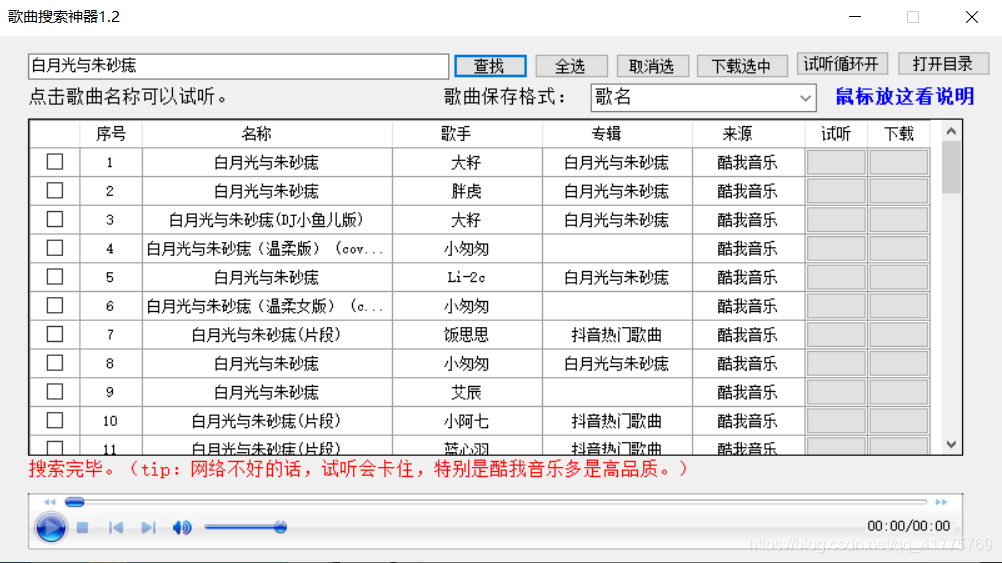现在写一篇博客总是喜欢先谈需求或者本内容的应用场景,是的,如果写出来的东西没有任何应用价值,确实也没有实际意义。今天的最早的需求是来自于如何免费[白嫖]下载全网优质音乐,我去b站上面搜索到了一个大牛做过的一个歌曲搜素神器,界面是这样的:
确实很好用的,而且涵盖了互联网上面大多数主流的音乐网站,涉及到的版本也很多,可谓大而全,但是一个技术人的追求远远不会如此,于是我就想去了解其中背后的原理,因为做过网络爬虫的人都知道,爬虫只能爬取某一页或者某些页的网站资源,所以我很好奇它背后是怎么实现的?
笔者一直以来都是做的基于Python3.7版本的网络爬虫,所以本文也是基于此来学习记录的。首先爬取的网站不是对应的音乐网站,而是一个音乐直链搜索,那里汇聚了大多数音频音乐的解析功能,界面如下:
所以自制一个搜索引擎的思想也很直观了,那就是利用第三方的接口,直接对该服务器发起请求即可,然后将获取的数据进行解析保存。这里以最近比较火的歌曲“白月光与朱砂痣”下载为例:
解析的结果如上,获取的数据格式是json类型,并且除了要有歌名以外,还要有音乐平台。
源代码实现如下:
import requests
import jsonpath
import os
"""
1.url
2.模拟浏览器请求
3.解析网页源代码
4.保存数据
"""
def song_download(url,title,author):
# 创建文件夹
os.makedirs("music",exist_ok=True)
path = 'music\{}.mp3'.format(title)
print('歌曲:{0}-{1},正在下载...'.format(title,author))
# 下载(这种读写文件的下载方式适合少量文件的下载)
content = requests.get(url).content
with open(file = title + author + '.mp3',mode='wb') as f:
f.write(content)
print('下载完毕,{0}-{1},请试听'.format(title,author))
def get_music_name():
"""
搜索歌曲名称
:return:
"""
name = input("请输入歌曲名称:")
print("1.网易云:netease\n2.QQ:qq\n3.酷狗:kugou\n4.酷我:kuwo\n5.百度:baidu\n6.喜马拉雅:ximalaya")
platfrom = input("输入音乐平台类型:")
print("-------------------------------------------------------")
url = 'https://music.liuzhijin.cn/'
headers = {
"user-agent":"Mozilla/5.0 (Windows NT 10.0; Win64; x64) AppleWebKit/537.36 (KHTML, like Gecko) Chrome/87.0.4280.141 Safari/537.36",
# 判断请求是异步还是同步
"x-requested-with":"XMLHttpRequest",
}
param = {
"input":name,
"filter":"name",
"type":platfrom,
"page": 1,
}
res = requests.post(url=url,data=param,headers=headers)
json_text = res.json()
title = jsonpath.jsonpath(json_text,'$..title')
author = jsonpath.jsonpath(json_text,'$..author')
url = jsonpath.jsonpath(json_text, '$..url')
if title:
songs = list(zip(title,author,url))
for s in songs:
print(s[0],s[1],s[2])
print("-------------------------------------------------------")
index = int(input("请输入您想下载的歌曲版本:"))
song_download(url[index],title[index],author[index])
else:
print("对不起,暂无搜索结果!")
if __name__ == "__main__":
get_music_name()
演示一下运行效果:
然后文件下就会出现对应的歌曲.mp3文件
并且每次的歌曲检索都是在PyCharm专业版的控制台中进行的,这样的用户体验就非常糟糕,所以针对以上两个问题,我对源代码进行了改进。
# 导入模块
from tkinter import *
import requests
import jsonpath
import os
from urllib.request import urlretrieve
# 2.功能实现
"""
1.url
2.模拟浏览器请求
3.解析网页源代码
4.保存数据
"""
def song_download(url,title,author):
# 创建文件夹
os.makedirs("music",exist_ok=True)
path = 'music\{}.mp3'.format(title)
text.insert(END,'歌曲:{0}-{1},正在下载...'.format(title,author))
# 文本框滑动
text.see(END)
# 更新
text.update()
# 下载
urlretrieve(url,path)
text.insert(END,'下载完毕,{0}-{1},请试听'.format(title,author))
# 文本框滑动
text.see(END)
# 更新
text.update()
def get_music_name():
"""
搜索歌曲名称
:return:
"""
name = entry.get()
platfrom = var.get()
# name = '白月光与朱砂痣'
url = 'https://music.liuzhijin.cn/'
headers = {
"user-agent":"Mozilla/5.0 (Windows NT 10.0; Win64; x64) AppleWebKit/537.36 (KHTML, like Gecko) Chrome/87.0.4280.141 Safari/537.36",
# 判断请求是异步还是同步
"x-requested-with":"XMLHttpRequest",
}
param = {
"input":name,
"filter":"name",
"type":platfrom,
"page": 1,
}
res = requests.post(url=url,data=param,headers=headers)
json_text = res.json()
title = jsonpath.jsonpath(json_text,'$..title')
author = jsonpath.jsonpath(json_text,'$..author')
url = jsonpath.jsonpath(json_text, '$..url')
print(title,author,url)
song_download(url[0],title[0],author[0])
# 1.用户界面
# 创建画板
root = Tk()
# 设置窗口标题
root.title('全网音乐下载器')
# 设置窗口大小以及出现的位置
root.geometry('560x450+400+200')
# 标签组件
label = Label(root,text="请输入下载的歌曲:",font=('楷体',20))
# 定位与布局
label.grid(row=0)
# 输入框组件
entry = Entry(root,font=('宋体',20))
entry.grid(row=0,column=1)
# 单选按钮
var = StringVar()
r1 = Radiobutton(root,text='网易云',variable=var,value='netease')
r1.grid(row=1,column=0)
r2 = Radiobutton(root,text='QQ',variable=var,value='qq')
r2.grid(row=1,column=1)
# 列表框
text = Listbox(root,font=('楷体',16),width=50,height=15)
text.grid(row=2,columnspan=2)
# 下载按钮
button1 = Button(root,text='开始下载',font=('楷体',15),command=get_music_name)
button1.grid(row=3,column=0)
button2 = Button(root,text='退出程序',font=('楷体',15),command=root.quit)
button2.grid(row=3,column=1)
# 显示界面
root.mainloop()
# 如何将.py代码打包成.exe文件
我们再来看看效果吧
这样加上了UI界面和部分代码优化之后,就可以通过.py代码打包成.exe文件发布给用户使用了。
